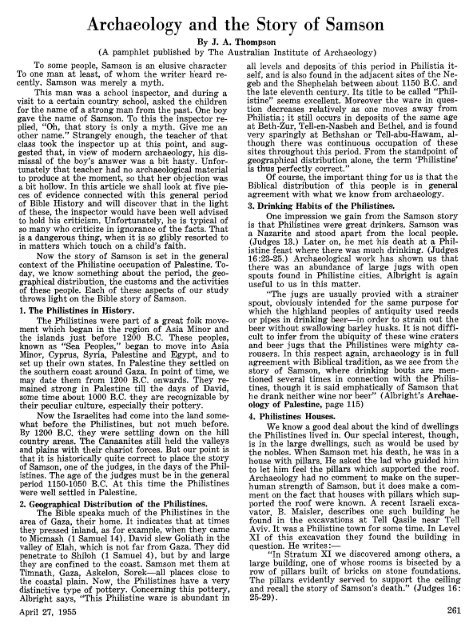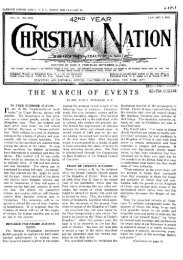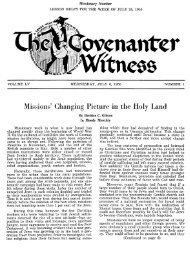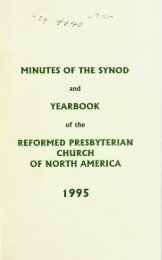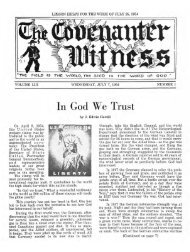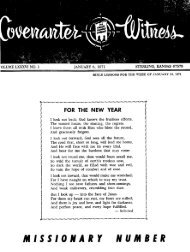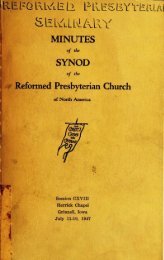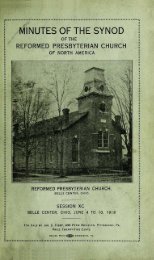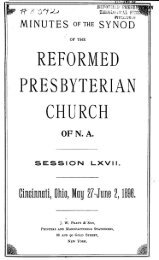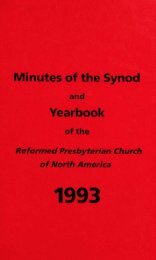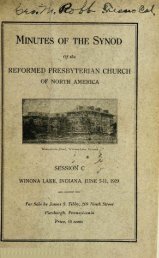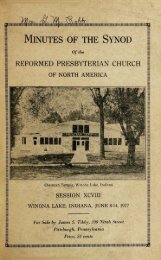Covenanter Witness Vol. 54 - Rparchives.org
Covenanter Witness Vol. 54 - Rparchives.org
Covenanter Witness Vol. 54 - Rparchives.org
Create successful ePaper yourself
Turn your PDF publications into a flip-book with our unique Google optimized e-Paper software.
name."<br />
correct."<br />
Archaeology and the Story<br />
of Samson<br />
By J. A. Thompson<br />
(A pamphlet published by The Australian Institute of Archaeology)<br />
To some people, Samson is an elusive character<br />
To one man at least, of whom the writer heard re<br />
cently, Samson was merely a myth.<br />
This man was a school inspector, and during a<br />
visit to a certain country school, asked the children<br />
for the name of a strong man from the past. One boy<br />
gave the name of Samson. To this the inspector re<br />
plied, "Oh, that story is only a myth. Give me an<br />
other Strangely enough, the teacher of that<br />
class took the inspector up at this point, and sug<br />
gested that, in view of modern archaeology, his dis<br />
missal of the boy's answer was a bit hasty. Unfor<br />
tunately that teacher had no archaeological material<br />
to produce at the moment, so that her objection was<br />
a bit hollow. In this article we shall look at five pie<br />
ces of evidence connected with this general period<br />
of Bible History and will discover that in the light<br />
of these, the inspector would have been well advised<br />
to hold his criticism. Unfortunately, he is typical of<br />
so many who criticize in ignorance of the facts. That<br />
is a dangerous thing, when it is so glibly resorted to<br />
in matters which touch on a child's faith.<br />
Now the story of Samson is set in the general<br />
context of the Philistine occupation of Palestine. To<br />
day, we know something about the period, the geo<br />
graphical distribution, the customs and the activities<br />
of these people. Each of these aspects of our study<br />
throws light on the Bible story of Samson.<br />
1. The Philistines in History-<br />
The Philistines were part of a great folk move<br />
ment which began in the region of Asia Minor and<br />
the islands just before 1200 B.C. These peoples,<br />
known as "Sea Peoples," began to move into Asia<br />
Minor, Cyprus, Syria, Palestine and Egypt, and to<br />
set up their own states. In Palestine they settled on<br />
the southern coast around Gaza. In point of time, we<br />
may date them from 1200 B.C. onwards. They re<br />
mained strong in Palestine till the days of David,<br />
some time about 1000 B.C. they are recognizable by<br />
their peculiar culture, especially their pottery.<br />
Now the Israelites had come into the land some<br />
what before the Philistines, but not much before.<br />
By 1200 B.C. they were settling down on the hill<br />
country areas. The Canaanites still held the valleys<br />
and plains with their chariot forces. But our point is<br />
that it is historically quite correct to place the story<br />
of Samson, one of the judges, in the days of the Phil<br />
istines. The age of the judges must be in the general<br />
period 1150-1050 B.C. At this time the Philistines<br />
were well settled in Palestine.<br />
2. Geographical Distribution of the Philistines.<br />
The Bible speaks much of the Philistines in the<br />
area of Gaza, their home. It indicates that at times<br />
they pressed inland, as for example, when they came<br />
to Micmash (1 Samuel 14). David slew Goliath in the<br />
valley of Elah. which is not far from Gaza. They did<br />
penetrate to Shiloh (1 Samuel 4), but by and large<br />
they are confined to the coast. Samson met them at<br />
Timnath, Gaza, Askelon, Sorek all places close to<br />
the coastal plain. Now, the Philistines have a very<br />
distinctive type of pottery. Concerning this pottery,<br />
Albright says, "This Philistine ware is abundant in<br />
April 27, 1955<br />
all levels and deposits of this period in Philistia it<br />
self, and is also found in the adjacent sites of the Ne<br />
geb and the Shephelah between about 1150 B.C. and<br />
the late eleventh century. Its title to be called "Phil<br />
istine"<br />
seems excellent. Moreover the ware in ques<br />
tion decreases relatively as one moves away from<br />
Philistia; it still occurs in deposits of the same age<br />
at Beth-Zur, Tell-en-Nasbeh and Bethel, and is found<br />
very sparingly at Bethshan or Tell-abu-Hawam, al<br />
though there was continuous occupation of these<br />
sites throughout this period. From the standpoint of<br />
geographical distribution alone, the term 'Philistine'<br />
is thus perfectly<br />
Of course, the important thing for us is that the<br />
Biblical distribution of this people is in general<br />
agreement with what we know from archaeology.<br />
3. Drinking Habits of the Philistines.<br />
One impression we gain from the Samson story<br />
is that Philistines were great drinkers. Samson was<br />
a Nazarite and stood apart from the local people.<br />
(Judges 13.) Later on, he met his death at a Phil<br />
istine feast where there was much drinking. (Judges<br />
16:23-25.) Archaeological work has shown us that<br />
there was an abundance of large jugs with open<br />
spouts found in Philistine cities. Albright is again<br />
useful to us in this matter.<br />
"The jugs are usually provied with a strainer<br />
spout, obviously intended for the same purpose for<br />
which the highland peoples of antiquity used reeds<br />
in order to strain out the<br />
or pipes in drinking beer<br />
beer without swallowing barley husks. It is not diffi<br />
cult to infer from the ubiquity of these wine craters<br />
and beer jugs that the Philistines were mighty carousers.<br />
In this respect again, archaeology is in full<br />
agreement with Biblical tradition, as we see from the<br />
story of Samson, where drinking bouts are men<br />
tioned several times in connection with the Philis<br />
tines, though it is said emphatically of Samson that<br />
he drank neither wine nor beer" (Albright's Archae<br />
ology of Palestine, page 115)<br />
4. Philistines Houses.<br />
We know a good deal about the kind of dwellings<br />
the Philistines lived in. Our special interest, though,<br />
is in the large dwellings, such as would be used by<br />
the nobles. When Samson met his death, he was in a<br />
house with pillars. He asked the lad who guided him<br />
to let him feel the pillars which supported the roof.<br />
Archaeology had no comment to make on the super<br />
human strength of Samson, but it does make a com<br />
ment on the fact that houses with pillars which sup<br />
ported the roof were known. A recent Israeli exca<br />
vator, B. Maisler, describes one such building he<br />
found in the excavations at Tell Qasile near Tell<br />
Aviv. It was a Philistine town for some time. In Level<br />
XI of this excavation they found the building in<br />
question. He writes :<br />
"In Stratum XI we discovered among others, a<br />
large building, one of whose rooms is bisected by a<br />
row of pillars built of bricks on stone foundations.<br />
The pillars evidently served to support the ceiling<br />
and recall the story of Samson's death." (Judges 16 :<br />
25-29).<br />
261


